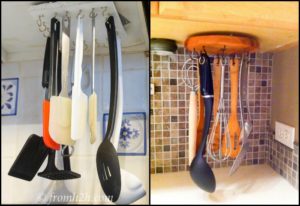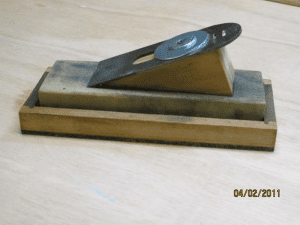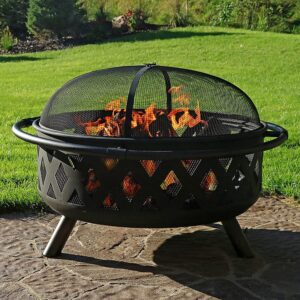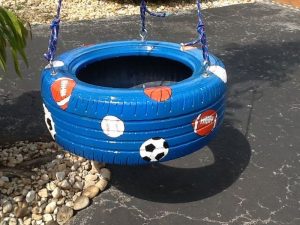Last Updated on August 21, 2024 by teamobn
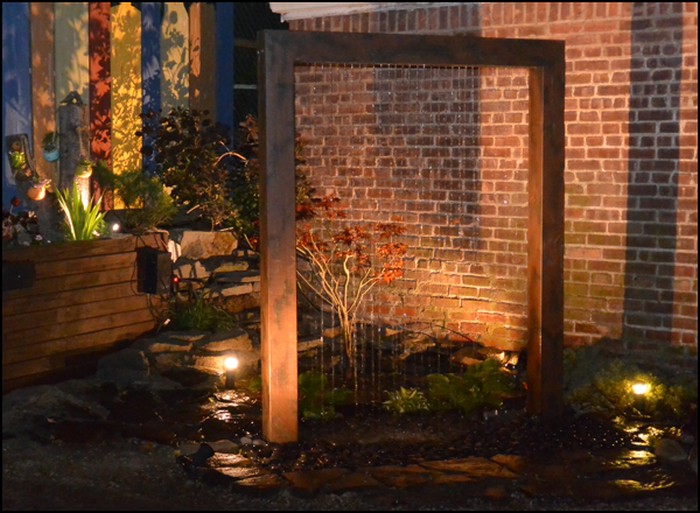
Your backyard is a place for your family to have fun together. It shouldn’t be a part of your home that you avoid because it has nothing to offer.
So a DIY project for you that will turn your backyard into an amazing outdoor space!
It looks magnificent, doesn’t it? This rain shower fountain was built by the owners themselves, and with the right tools, you can definitely build one yourself too!
It’s a simple but elegant rain shower fountain that will no doubt look great in any garden. You can also get waterproof LED strip lighting and install it above or below the waterline so that the water droplets are more visible. You can also do a bit of research to see if other lighting options are available to produce awesome visual water effects!
Crafting a captivating rain shower fountain for your backyard can transform it into a serene oasis. Here are five essentials to guide you in building your own beautiful rain shower fountain:

- Solid Foundation and Structure: Start by crafting a sturdy foundation and structure for your fountain. Choose durable materials like concrete, stone, or weather-resistant metals to ensure stability and longevity. Ensure the foundation is level and adequately supported to prevent shifting or tilting over time.
- Water Source and Plumbing: Determine the water source for your fountain and plan the plumbing accordingly. You can connect it to your home’s water supply or use a recirculating pump system for water conservation. Install pipes, valves, and fittings to deliver water to the top of the fountain, where it will cascade down in a gentle, soothing rainfall effect.
- Shower Head Design: Select a shower head design that suits your aesthetic preferences and complements your backyard’s style. Options include traditional rainfall shower heads, cascading waterfall heads, or customizable fixtures with adjustable settings. Consider factors such as water flow rate, spray pattern, and coverage area to achieve the desired visual and auditory ambience.
- Decorative Accents: Enhance the visual appeal of your rain shower fountain with decorative accents and elements. Incorporate materials like mosaic tiles, glass pebbles, or natural stones to add texture and visual interest. Integrate LED lighting features to illuminate the fountain and make a mesmerizing nighttime display. Additionally, consider surrounding the fountain with lush greenery, flowering plants, or decorative landscaping to further enhance its beauty.
- Maintenance and Care: Implement a regular maintenance routine to ensure the longevity and optimal performance of your rain shower fountain. Clean the fountain regularly to remove debris, algae, and mineral deposits that can accumulate over time. Inspect the plumbing system and water circulation components periodically to detect and address any issues promptly. Protect the fountain from harsh weather conditions by covering it or draining it during the winter months. With these essentials in mind, you can create a stunning rain shower fountain that enhances the beauty and tranquility of your backyard.
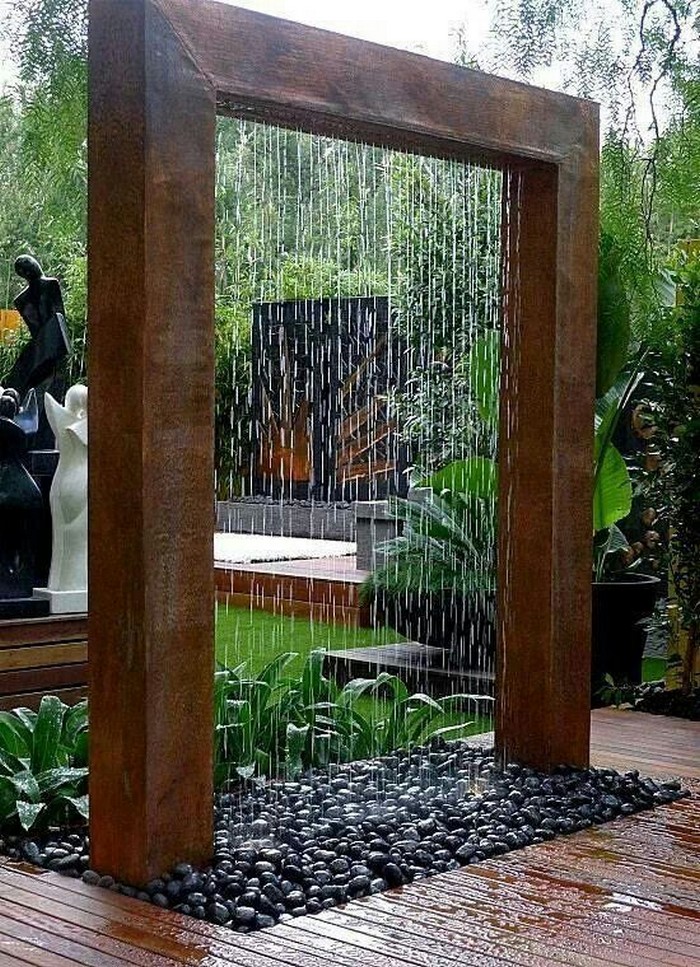
No matter what size your garden is, you can always build a rain shower fountain by simply adjusting the dimensions according to your space. Even a mini version will bring life to your backyard garden, especially at night!
Do you think your garden could use a rain shower fountain? 
By incorporating these five essentials into your rain shower fountain design, you can create a stunning focal point for your backyard that adds beauty, tranquility, and the soothing sound of falling water. Whether you’re relaxing in the garden, entertaining guests, or simply enjoying the outdoors, your rain shower fountain will provide a sense of serenity and luxury to your outdoor living space.
Click on any image to start the lightbox display. Use your Esc key to close the lightbox.![]()
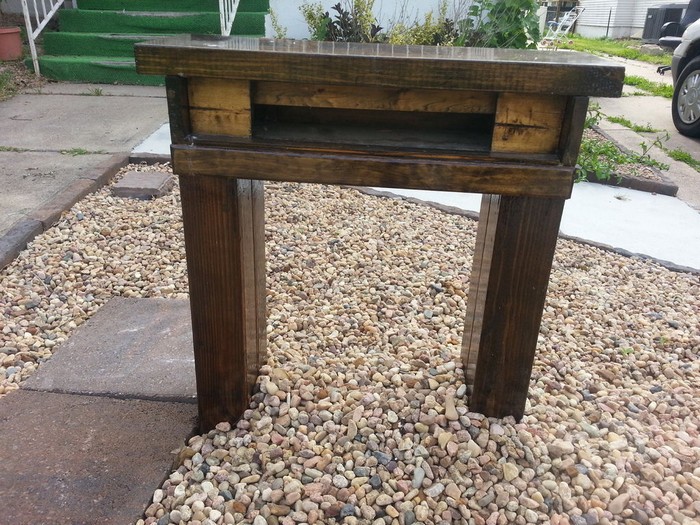

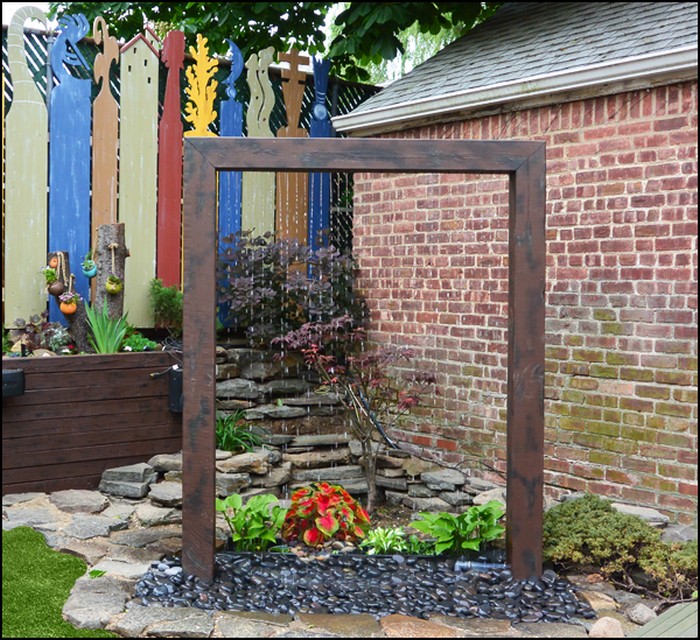
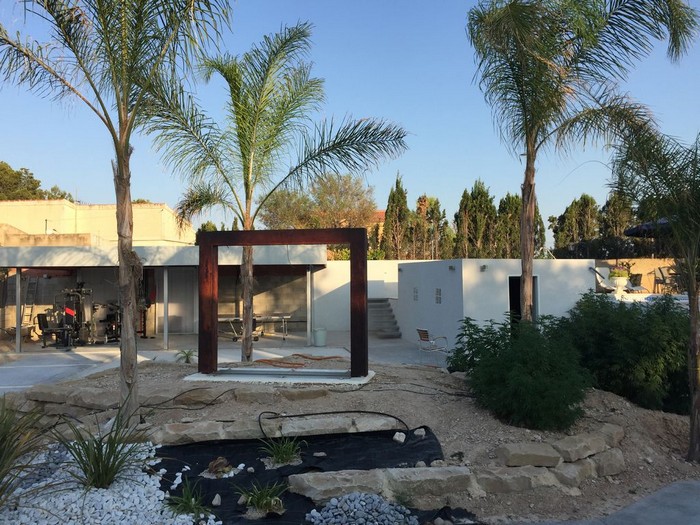
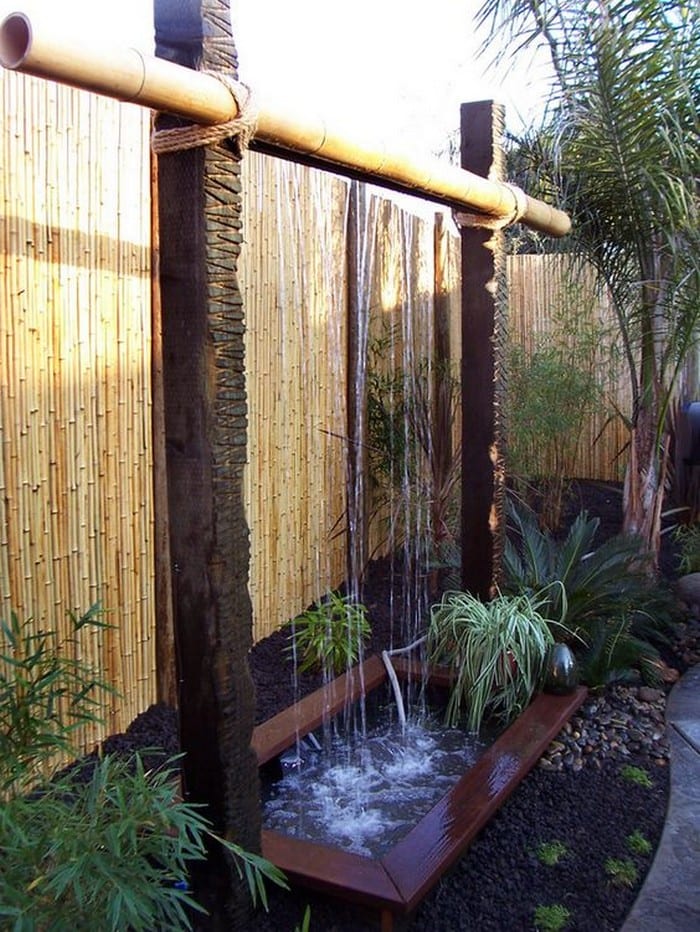

How to Build a Rain Shower Fountain
Materials:
- 3 pcs 6”x6”x8’ Pressure Treated Lumber
- 10’ 1 ¼” Copper Pipe
- 2 pcs 1 ¼” Copper Elbows
- Blow Torch and Copper Solder OR Copper Epoxy
- 3’ of 1 ½” ID Plastic Tubing and (2) 1 ½” Elbows
- 2’ of Toro Blue Stripe ½” Drip Tubing
- Pondmaster MDWP-20 Waterfall Pump
- 1-½” PVC Ball Valve
- Exterior Wood Stain
- 5 bags 50lb Fast Set Concrete
- HDX 55 Gallon Tough Tote Plastic Storage Container
- 40 mil PVC Pond Liner 5’ x 8’
- 8 pcs 3/8” x 6” Landscape Timber Lag Screws
- 200 lbs Black Mexican Beach Pebbles

And these tools:
- Spirit Level
- Post Hole Digger or Shovel
- Miter Saw (optional)
- Drill (with ¼” drill bit and 1 ½” hole saw bit)
- Router (with 1” dish carving router bit and ½ “ straight router bit)
- Oscillating Multi Tool OR Wood Chisel
Steps:

Prep the area: We removed the rocks, and an old pond, cut down the existing trees and bushes, and levelled the surface for the rain shower fountain.

Cut and mitre the beams: The finished size of the rain shower fountain will be 65” wide x 80” high (this is the exposed size – remember that there is an extra 16” height buried in the ground). This makes our 2 vertical beams 96” each, and the horizontal beam 65”. Mitering the corners was difficult, due to the size of the beams, so this is optional.
If you decide not to miter, just stack the top beam onto the vertical ones – it will still look good, and save you quite a bit of work. If you do this, though, just remember to cut 5 1/2” off the vertical beams to make up for the extra height, and to keep the same height-width ratio of the finished product.

Make the horizontal beam with water pipe assembly: If you’re facing the rain shower fountain, your water supply line will be on the RIGHT side. So, start on the LEFT side of the horizontal beam, and cut a channel into the underside of the beam to hold the copper pipe.
Since the wood is pretty dense, we’re going to do this in progressive steps. First, use a straight ½” router bit and make a channel ¾” deep. Stop about 1” from the RIGHT end. Then, run a 1” dish carving bit along the left edge of the channel. Finish by running this same bit on the right edge of the channel. This will provide enough space for the 1 ¼” copper pipe.
Next, we’ll finish off the RIGHT end of the rain shower fountain by cutting a 1 ½” hole so the pipe can pass through.

Drill water flow holes for the copper pipe and insert it into the routed beam: Insert the copper pipe into the beam. Then Drill ¼” hole into every 1” of the copper pipe. Blow out the metal shavings and make sure the inside of the pipe is clean. Solder a cap onto the LEFT end of the copper pipe.
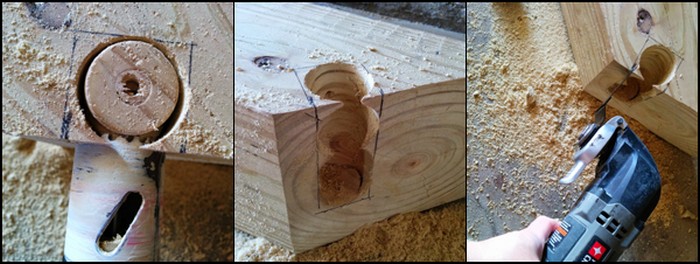
Cut right side vertical beam for pipe fitting: Now we have to make a cutout in the RIGHT vertical beam to make room for the pipe. Using a 1 ½” hole saw, cut a channel for the pipe.

Finish copper pipe assembly: Solder the connections. Note that we placed a rag soaked in cold water on the pipe, a few inches from the connection. This keeps the pipe cool enough to prevent damage to the wood while soldering.

Next, we take ¼” of a Toro Blue Stripe drip line and cut it into ½” pieces. We insert a piece into each hole of the copper pipe. This is important because the tubing causes the water to flow straight down. Without it, the water of the rain shower fountain will flow in uneven directions.
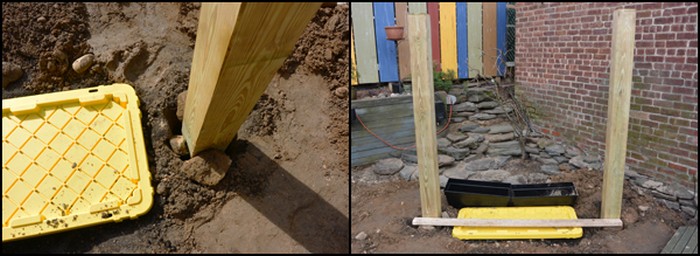
Dig holes for beams and water container – check for proper fit: We’re setting the beams 16” into the ground. The water container is actually a 55-gallon storage bin from Home Depot. You can use whatever size you have available, preferably over 20 gallons so you’re not constantly refilling with water. Make sure your holes are of equal depth and the height of the beams are identical.

Stain the beams: First, apply a base coat of Padre Brown. When dry, lightly sponge on some Ponderosa Green followed by Colonial Yellow in random patterns. Finish by sponging Slate to form your desired pattern.
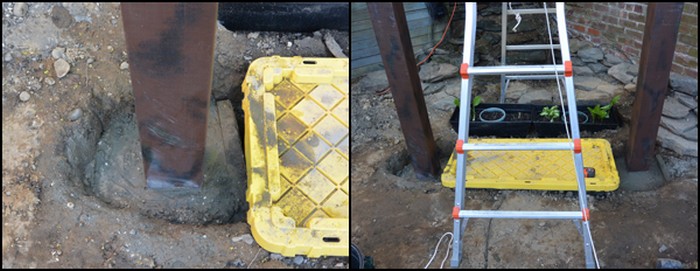
Set beams into concrete: It’s easier to set one beam of the rain shower fountain at a time. Make sure it’s straight, level, and properly positioned, then pour in the fast-setting cement. It only takes about 30 minutes to dry, then you can do the second beam, carefully aligning it to the first.

Install top beam: Once the concrete base has fully set, you can install the top beam. Secure it with 3/8” x 6” Landscape Timber screws. BE CAREFUL NOT TO SCREW INTO COPPER PIPE!

Prep container lid: The storage container we used has a lid, so we just cut a hole in it for the water flow and plastic tubing. If you’re using an open container, you’ll need to put a grate over it to hold the pebbles.
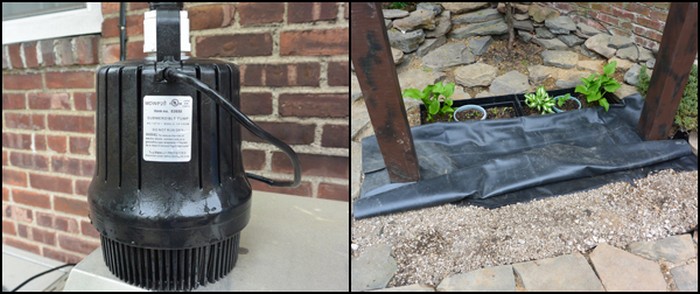
Put the water pump into a container and place a PVC liner over the container: Put the pump inside the container, running tubing and cord out through the hole in the lid. Then cut your PVC pond liner to fit. This rain shower fountain splashes a lot of water, so just allow enough room to catch the water and direct it back to the container. With the PVC liner in place, cut a hole to correspond with the hole you cut in the container lid.
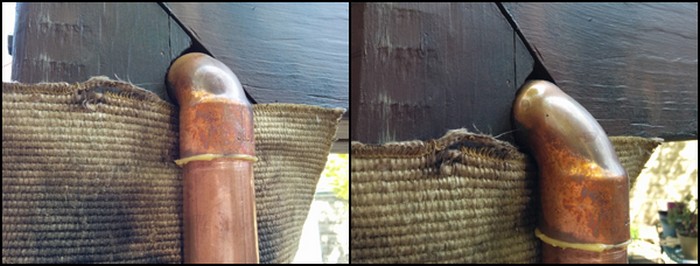
Connect copper pipes and water line: Now we solder the last pipe – notice that we used a flame shield to protect the wood while soldering. If you don’t want to solder, some epoxies are made for copper pipes. That would be much easier, but we’ve never used them, so we’re not sure how well it will hold up.
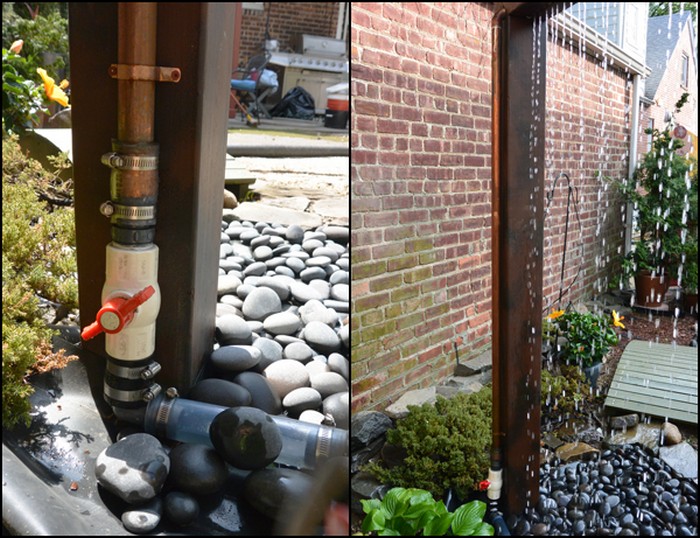
Connect the water pump and cover it with beach pebbles: We connected a valve to control the flow of water. Without it, the water flow is too strong, so this allows a range of adjustments.

Admire your hard work! Look at the shot of our contemporary rain shower fountain at night!
Thanks to gracechichi for this great project! Checking the latest and most relevant sources for up-to-date information.
When installing a rain shower fountain though, it’s important to consider safety precautions to avoid accidents and ensure the well-being of those enjoying the feature.
Some safety precautions to keep in mind:
- Electrical Safety: If your rain shower fountain includes lighting features or a recirculating pump system, ensure that all electrical components are installed and maintained by a qualified professional. Use weatherproof outlets, waterproof wiring, and ground fault circuit interrupters (GFCIs) to minimize the risk of electric shock.
- Secure Installation: Ensure that the rain shower fountain is securely installed on a stable surface to prevent tipping or collapse. Follow manufacturer guidelines for installation and use appropriate anchors and fasteners to secure the fountain to the ground or other structures.
- Slip Resistance: Consider the surface surrounding the rain shower fountain to prevent slips and falls, especially when water may splash onto nearby walkways or patios. Choose non-slip materials for pathways and ensure proper drainage to avoid having standing water.
- Water Safety: If your rain shower fountain includes standing water, take precautions to prevent drowning, especially if children or pets have access to the area. Install safety barriers or covers to restrict access to the fountain, and supervise children and pets when they are near the water.
- Regular Maintenance: Implement a regular maintenance routine to keep the rain shower fountain clean and in good working condition. Clean the fountain regularly to remove debris, algae, and mineral deposits that can accumulate over time. Inspect the plumbing system and water circulation components periodically to detect and address any issues promptly.
- Weather Protection: Protect the rain shower fountain from harsh weather conditions such as freezing temperatures or heavy storms. Consider covering the fountain or draining it during the winter months to prevent damage from freezing water. Use pipe insulation sleeves or wrap them with towels or blankets to provide an extra layer of protection against the cold. Be sure to secure the insulation in place with tape or zip ties to prevent it from coming loose.
By following these safety precautions, you can enjoy your rain shower fountain with peace of mind, knowing that it enhances your outdoor space while prioritizing the safety of your family and guests.
The Wrap Up
Building a beautiful rain shower fountain for your backyard requires careful consideration of five essential elements: a solid foundation and structure, a reliable water source and plumbing system, a well-chosen shower head design, decorative accents to enhance visual appeal, and a maintenance plan to ensure longevity and optimal performance.
By focusing on these essentials, you can make a captivating focal point that transforms your outdoor space into a serene oasis, where the soothing sound of cascading water and the mesmerizing beauty of the fountain bring joy and tranquility to your surroundings. With creativity, attention to detail, and regular upkeep, your rain shower fountain will continue to delight and inspire for years to come.
Frequently Asked Questions
1. What is a rain shower fountain?
A rain shower fountain is an outdoor water feature designed to simulate the gentle cascade of rainfall. It typically consists of a showerhead or similar fixture that releases water in a cascading manner, creating a soothing and visually appealing effect.
2. What are the advantages of having a rain shower fountain?
Rain shower fountains add a touch of elegance and tranquility to outdoor spaces. They can enhance relaxation, provide a focal point for outdoor gatherings, and attract wildlife to your garden. Additionally, the soothing sound of flowing water can promote a sense of calm and well-being.
3. Do rain shower fountains require a lot of space?
Rain shower fountains come in various sizes and designs to suit different outdoor spaces. Whether you have a small patio or a spacious backyard, there are options available to fit your needs.
If you’re fortunate enough to have a spacious backyard, you can opt for larger rain shower fountain models that make a bold statement and become a stunning focal point of your outdoor landscape. These grand fountains come in a variety of styles, from classic and traditional to modern and avant-garde, allowing you to choose the perfect design that complements your backyard aesthetic.
4. Are rain shower fountains difficult to install?
The level of difficulty for installation depends on the complexity of the fountain design. Some fountain kits are designed for easy DIY installation, while more intricate designs may require professional assistance, especially if they involve plumbing or electrical work.
5. Are rain shower fountains environmentally friendly?
Rain shower fountains can be environmentally friendly if designed with water conservation in mind. Using recirculating pump systems and energy-efficient LED lighting can help reduce water and energy consumption.
6. How do you maintain a rain shower fountain?
Regular maintenance is essential to keep your rain shower fountain in good condition. This may include cleaning the fountain to remove debris and algae, checking plumbing and electrical components, and ensuring proper water circulation.
7. Are rain shower fountains safe for children and pets?
Safety precautions should be taken to prevent accidents, especially if children or pets have access to the fountain. Installing safety barriers, supervising children and pets, and using non-slip materials around the fountain area can help ensure safety.

